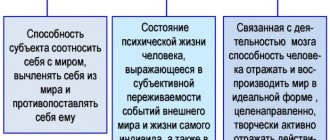Lesson plan:
What is consciousness
Individual and social consciousness
Self-awareness
Self-esteem of personality
The sphere of the unconscious: cognition and its levels
Unlike animals, people are able to realize what is happening to them and change the current situation. People understand that their every word and action will have certain consequences, so a person is able to restrain his instincts, passions, and emotions. Such self-control is possible due to the presence of consciousness in people.
The essence of consciousness and its structure
Consciousness is one of the basic concepts not only of psychology, but also of philosophical science.
In philosophy, the concept of consciousness is revealed by comparing it with another important philosophical concept - “matter”. Therefore, understanding the essence of consciousness turns out to depend on the way of solving the question of the relationship between matter and consciousness, on the understanding of consciousness in a broad or narrow sense.[2, p.73]
When understanding consciousness in a broad sense, it is interpreted as an independent entity, a substance capable of creating the world. Such a substantial, broad understanding of consciousness is characteristic of idealistic philosophy.
In materialist philosophy, the term “consciousness” is used in a different, narrower sense. Here it loses the character of an independent essence and takes on the appearance of only one of the properties of matter, moreover, a property that arises only with the appearance of highly organized matter - the human brain. Here the role of the eternal and infinite substance, the origin, is transferred to matter. In this narrow sense, consciousness turns out to be not a universal principle, but only one of the forms of being, and a secondary form, closely related to matter, without which it cannot exist. In the understanding of materialists, it is not consciousness that gives rise to matter, but on the contrary, matter gives rise to consciousness as a secondary being.
The origin of consciousness, with its different understanding - in the broad and narrow sense - is explained in different ways.
Consciousness in a broad, substantial sense is eternal, and therefore the question of its origin is not even raised in idealistic philosophy. In this sense, as noted, it is close to the concept of God, circumstances whose appearance in religion and religious philosophy are also not discussed.
Introduction
Human consciousness is a complex phenomenon; it is multidimensional, multidimensional. The versatility of consciousness makes it an object of study for many sciences, including psychology.
The problem of consciousness has always attracted the close attention of psychologists and philosophers, because determining the place and role of man in the world, the specifics of his relationship with the surrounding reality presupposes clarification of the nature of human consciousness.
From the point of view of psychology, consciousness acts as a special form of reflection, regulation and management of people’s attitude to the surrounding reality, to themselves and their methods of communication, which arise and develop on the basis of practically transformative activity. It not only reflects, but also creates the world. Consciousness is a social product from the very beginning. It arises and develops only in the joint activity of people in the process of their work and communication.
For philosophy, this problem is important because certain approaches to the question of the essence of consciousness, the nature of its relationship to being, affect the initial ideological and methodological guidelines of any philosophical direction. Naturally, these approaches are different, but all of them, in essence, always deal with a single problem: the analysis of consciousness as a specifically human form of regulation of human interaction with reality.
Structure and functions of self-awareness
Regarding the structure of the concept in psychology, there is also no single approach; several alternatives are considered.
Thus, in the works of V.S. Mukhina’s self-awareness includes: identification of a person with his own property and physical body, gender, self-esteem and claims to evaluation by society.
V.S. Merlin sees the structure of the concept somewhat differently and includes in it:
- Understanding personal mental characteristics.
- Awareness of the “I” as an active subject.
- Recognition of personal identity.
- Assessing one’s own mental qualities from the point of view of moral and ethical rules.
V.V. Stolin defines the following parts of self-understanding: self-esteem, the created image of oneself (body, emotions, feelings), the conflicting essence of one’s “I”.
Summarizing the existing concepts, the structure of self-knowledge can be represented as follows:
- educational part
– a person’s awareness of all aspects of his own personality;
- self-esteem
– a person’s attitude to his characteristics, both physical and spiritual, emotional;
- self-regulation
– a person’s ability, based on knowledge about himself, to control, regulate and correct his behavior and actions.
In addition to different periods of life, the structure of self-understanding also includes:
- "I" today
. This is an idea of one’s personality at the current moment in time, an awareness of one’s position in reality. We evaluate existing social roles: what kind of worker, husband, father, etc. am I. If the ideal image and the real one do not coincide, experiences may arise. - "I" is desired
. These are a person’s ideas about the ideal image to which he strives. This component includes: needs, dreams and desires. It is this “I” that is the main motivator for productive activity. - “ I” is previous, including an assessment of oneself in the past
. If a person has had unpleasant or painful experiences early in life, this may hinder the fulfillment of needs in the future.
All of the listed components of self-awareness are interconnected and influence each other.
Functions
The most important function of self-awareness is self-regulation
. Since we have fully identified ourselves, realized resources (positive and negative characteristics, potential, opportunities), understand needs and desires, he can act towards creating his ideal image.
When a person is mistaken about his own needs or inadequately assesses available opportunities, he will not receive satisfaction from his activities. Either he will rush in the wrong direction, or he will not have enough strength and potential to fulfill his desire. In both cases, disappointments and the occurrence of frustrations (strong experiences due to unfulfilled hopes and expectations) are inevitable.
Self-regulation will save a person from pointlessly wasting energy and time on unnecessary goals.
The next function is self-understanding
- This is the formation of individuality. Personality is always unique, each of us is unique. Only we ourselves know what feelings we experience, how we react to difficulties and obstacles, our pain is only our pain.
We have the right to our own perception of life, personal opinion and want to be responsible for our actions. Individuality and uniqueness must be defended throughout life.
Among the main functions are the definition of personal boundaries, self-defense
. We learn to structure our behavior in such a way that we experience less toxic influence from others. Extraordinary individuals are often ostracized (persecuted) in society. Unusual abilities and appearance, one’s own view of things, different from the generally accepted one, often make a person a “black sheep” that his brothers try to peck. A conscious sense of peace and self-confidence allows you to build a strong line of defense.
For example, if a person loves his body, he will not pursue imposed standards of beauty, if he considers it immoral to do mean things, he will not make a career by “setting up” his colleagues, even if this is accepted in the team, etc.
There is such a technique in psychology. If you are confident that you are right and live according to the principles you have developed, then in the event of attacks, imagine yourself as a rubber ball that no one can pinch. It is better to lose a toxic environment than to lose yourself.
Psychic phenomena
The main interest of psychology is the so-called personal manifestations of the unconscious, in which, in addition to the desire, consciousness and will of a person, the unconscious manifests itself in its deepest features. Sigmund Freud made a great contribution to the development of problems of the personal subconscious. The unconscious of the human personality consists of those qualities, interests, needs that are not consciously perceived by a person, but which are inherent in him and manifest themselves in various involuntary reactions, actions and mental phenomena.
The first group of mental phenomena are erroneous actions: Booking, errors in writing and hearing words. Slips of the tongue are unconsciously determined articulatory speech acts associated with distortion of the sound base and meaning of spoken words. Such distortions, especially of a semantic nature, are not accidental. S. Freud argued that they manifest motives, thoughts and experiences hidden from human consciousness. Reservations arise when a person’s unconscious intentions, his other motives, collide with the conscious purpose of behavior that contradicts the ulterior motive. When the unconscious overcomes consciousness, a slip occurs. It is this psychological mechanism that underlies all erroneous actions: they “arise as a result of the interaction, or rather, the opposition of two different intentions.”
The second group of phenomena is involuntary forgetting of names, promises, intentions, objects, events. Forgetting names is associated with the forgetful person's unpleasant feelings towards the person with the forgotten name or towards events associated with that name. Such forgetting usually occurs against the will of the speaker, and this situation characterizes most cases of forgetting names.
The third group of personal phenomena belongs to the category of representations and is associated with perception, memory and imagination: Dreams, dreams and dreams. According to Freud, the content of dreams is associated with a person’s unconscious desires, feelings, intentions, his unsatisfied or not fully satisfied important life needs.
A.N. Leontiev developed three components of the structure of individual consciousness - the sensory fabric of consciousness, meaning and personal meaning.
The sensory tissue of consciousness “forms the sensory composition of specific images of reality that are actually perceived or arise in memory.” These images differ in modality, sensory tone, degree of clarity, and greater or less stability. The special function of semantic images of consciousness is that they give reality to the conscious image of the world as it is revealed to the subject. In other words, through the semantic content of consciousness, the world appears to the subject as existing not in consciousness, but outside his consciousness - as an objective “field” and the object of his activity.” Meanings are the general content of words, diagrams, maps, drawings, understandable to all people speaking the same language, belonging to the same culture or similar cultures that have gone through a similar historical path. The experience of humanity is generalized, crystallized and thereby preserved for future generations. By comprehending the world of meaning, a person learns, becomes acquainted with this experience and can contribute to it. The universal language of meaning is the language of art - music, dance, painting, theater, the language of architecture.
Developing Self Awareness
Self-awareness appears in a child in early infancy, and by adolescence it is fully formed. However, this does not mean that you do not need to engage in self-perception throughout your life.
Changes occur in the objective world and subjective characteristics. These changes require observation and self-knowledge.
The first step is to analyze the current external and internal situations and re-recognize yourself and your attitude to changes. For example, with age, the body begins to age and our attitude towards it, formed in early periods, will also change. On the one hand, it is required to take greater care of physical health, on the other hand, to be able to accept age-related changes without unnecessary worries, with dignity.
It is also important to bring self-esteem to an adequate (normal) state. Throughout life, the level of love and self-respect may change due to external reasons or the attitude of loved ones. You cannot allow circumstances to sow doubts about your self-confidence.
And lastly, it is necessary to promptly adjust needs and actions according to life changes. It is impossible to stop at knowing about yourself; taking the same actions that do not lead to success is not constructive. Therefore, the process of self-awareness is permanent and ends only after the physical death of a person.








